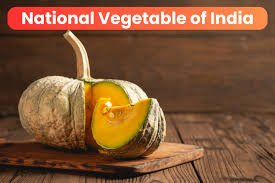National Vegetable of India Declared: A Landmark Decision
Introduction of the National Vegetable
In a landmark decision, the Indian government has officially declared the pumpkin as the National Vegetable of India. This designation marks a significant step in recognizing the cultural and nutritional importance of this versatile vegetable across the country. The announcement was made by the Ministry of Agriculture and Farmers’ Welfare, highlighting the pumpkin’s role in Indian agriculture and cuisine.
Nutritional and Culinary Significance
Pumpkins are not only a staple in Indian kitchens but also a vegetable rich in essential nutrients. They are packed with vitamins, minerals, and antioxidants, contributing to overall health and well-being. The pumpkin’s versatility is evident in its usage across various Indian dishes, from soups and curries to sweets and snacks. This recognition aims to boost awareness about its health benefits and encourage its consumption.
Economic Impact on Agriculture
The designation of the pumpkin as the National Vegetable is expected to have a positive impact on Indian agriculture. By promoting the pumpkin, the government aims to increase its production and marketability, providing economic benefits to farmers. This move is part of a broader strategy to support the agriculture sector and improve the livelihoods of farmers through enhanced crop value and demand.
Cultural and Regional Importance
The pumpkin holds a special place in Indian culture and traditions. It is featured prominently in various regional festivals and ceremonies. By officially recognizing the pumpkin, the government seeks to honor its cultural significance and promote its role in regional cuisines. This step is also seen as a way to celebrate India’s agricultural diversity and heritage.
Government Initiatives and Support
The government plans to implement several initiatives to support pumpkin cultivation. These include providing subsidies for pumpkin seeds, improving irrigation facilities, and offering training programs for farmers. Additionally, efforts will be made to create awareness about the benefits of pumpkin and encourage its use in school feeding programs and public health campaigns.

Why This News is Important
Promoting Nutritional Awareness
The recognition of the pumpkin as the National Vegetable highlights its nutritional value and the importance of including it in daily diets. By raising awareness about its health benefits, the government aims to encourage healthier eating habits among the Indian population. This move aligns with broader public health objectives to improve nutrition and reduce diet-related health issues.
Boosting Agricultural Economy
Designating the pumpkin as the National Vegetable is expected to stimulate its production and market demand. This, in turn, will benefit farmers by increasing their income and promoting sustainable agricultural practices. The economic boost from this decision will contribute to the overall growth of the agricultural sector.
Cultural Recognition
The pumpkin’s designation as the National Vegetable acknowledges its cultural significance in India. It reflects the government’s commitment to preserving and celebrating regional traditions and agricultural diversity. This recognition fosters a sense of national pride and unity through shared cultural practices.
Encouraging Sustainable Practices
The focus on promoting pumpkin cultivation supports sustainable agricultural practices. By investing in the production of this versatile vegetable, the government aims to enhance food security and reduce reliance on imported vegetables. This approach aligns with environmental sustainability goals and supports local farming communities.
Supporting Farmers
The government’s initiatives to support pumpkin cultivation provide farmers with the resources and training needed to improve their productivity. By enhancing the value of pumpkin crops, the government is helping to ensure a stable income for farmers and encouraging their participation in national agricultural programs.
Historical Context
Early Cultivation of Pumpkins
Pumpkins have been cultivated in India for centuries, with evidence of their use dating back to ancient times. Historically, they have been an integral part of Indian agriculture and cuisine. Early records show that pumpkins were grown in various regions, reflecting their adaptability to different climates and soil types.
Cultural Significance
The pumpkin has long been associated with Indian festivals and traditional practices. In various regions, it is used in religious ceremonies and community feasts, symbolizing prosperity and abundance. The vegetable’s role in these cultural events underscores its importance in Indian heritage.
Modern Agricultural Practices
In recent decades, the focus on improving agricultural practices has led to the adoption of advanced techniques for pumpkin cultivation. The introduction of high-yielding varieties and modern irrigation methods has enhanced production and marketability. The government’s recent decision builds on these advancements to further promote pumpkin cultivation.
Government Policies
Previous government policies have supported the agriculture sector through subsidies, research, and development programs. The designation of the pumpkin as the National Vegetable is a continuation of these efforts, aiming to enhance the agricultural economy and support farmers.
Key Takeaways from National Vegetable of India
| Serial Number | Key Takeaway |
|---|---|
| 1 | The pumpkin has been officially declared the National Vegetable of India. |
| 2 | This designation aims to promote the nutritional and health benefits of pumpkin. |
| 3 | The move is expected to boost the agricultural economy by increasing pumpkin production and market demand. |
| 4 | The government will provide support to farmers through subsidies and training programs for pumpkin cultivation. |
| 5 | The pumpkin’s cultural significance is acknowledged, reflecting its role in Indian traditions and festivals. |
Important FAQs for Students from this News
1. What is the newly declared National Vegetable of India?
The pumpkin has been officially declared the National Vegetable of India.
2. Why has the pumpkin been chosen as the National Vegetable?
The pumpkin was chosen due to its nutritional benefits, culinary versatility, and economic significance in Indian agriculture.
3. How does the designation of the pumpkin impact Indian agriculture?
The designation is expected to increase pumpkin production and market demand, benefiting farmers and boosting the agricultural economy.
4. What government initiatives are planned to support pumpkin cultivation?
The government plans to provide subsidies for pumpkin seeds, improve irrigation facilities, and offer training programs for farmers.
5. What cultural significance does the pumpkin hold in India?
The pumpkin is featured in various regional festivals and ceremonies, symbolizing prosperity and abundance in Indian culture.
Some Important Current Affairs Links


















